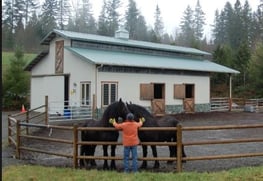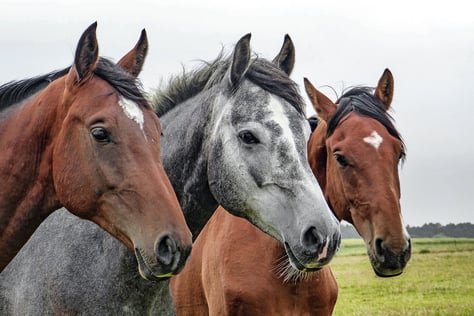 A few months ago, we asked our readers what topics they'd be most interest in learning more about in our "Barn Bits" enewsletter and our blog. The overwhelming leading concern for horse owners was - fire. Every year, thousands of acres of land are burned and hundreds of homes and buildings destroyed. However, every once in awhile a miracle happens - a lone house remains standing, untouched, while the area around it is completely destroyed. Here are some tips on how you can help better the odds that your barn becomes one of the survivors.
A few months ago, we asked our readers what topics they'd be most interest in learning more about in our "Barn Bits" enewsletter and our blog. The overwhelming leading concern for horse owners was - fire. Every year, thousands of acres of land are burned and hundreds of homes and buildings destroyed. However, every once in awhile a miracle happens - a lone house remains standing, untouched, while the area around it is completely destroyed. Here are some tips on how you can help better the odds that your barn becomes one of the survivors.
Look at building material options
While we all love the look of wood barns, but if you live in a high fire danger area, you may want to consider a non-wood barn. They come in the same variety of styles as traditional wood barns, but are made out of steel or out of masonry material, such as brick, concrete block, poured cement, and stone. At the very least, consider a metal roof on your barn. Many wildfires start from flying embers landing on roofs and a metal roof can help minimize this. The interior barn stalls can also be made with fire-resistant materials such as mesh or steel. Use steel, woven wire or electric fencing rather than wood for paddocks, turnout areas and arenas. A few months ago, we asked our readers what topics they'd be most interest in learning more about in our "Barn Bits" enewsletter and our blog. The overwhelming leading concern for horse owners was - fire. Every year, thousands of acres of land are burned and hundreds of homes and buildings destroyed. However, every once in awhile a miracle happens - a lone house remains standing, untouched, while the area around it is completely destroyed. Here are some tips on how you can help better the odds that your barn becomes one of the survivors.
Create a defensible space with fire resistant landscaping.
Establish a “defensible space” of at least 50 feet around your barn. This is the area where potential fire-spreading fuel has been modified, reduced or cleared to create a barrier and slow the spread of fire. It also is a space where firefighters can battle the fire safely and efficiently.
Remove wooden picnic tables or patio furniture, dead/dry leaves, plants, grass and weeds and any dead branches.
Replace vegetation with fire resistant plants - NOTE: FIRE RESISTANT DOES NOT MEAN FIREPROOF! Fire resistant plants do not readily ignite from a flame. While the plant can be damaged or killed by fire, they do not significantly contribute to a fire’s intensity. Some fire resistant plants, shrubs and trees include: yarrow, coreopsis, coneflower, lavender, salvia, Russian sage, dwarf burning bush, roses (rosa species), Ponderosa pine, and alder, redbud and flowering dogwood trees. Most of these are not only fire resistant, but also drought tolerant and animal safe.
If you are considering using wood mulch around your landscaping, consider using less flammable types of mulch, such as gravel or decorative rock or a combination of wood mulch and decorative rock (surround islands of bark mulch around plants by larger areas of gravel or rocks).
Remember the basics of fire prevention:
No smoking EVER on the premises.
Keep hay and shavings storage as far away from the barn as possible.
Have electrical wiring regularly checked.
Have several fire extinguishers located throughout the barn and make sure all staff and boarders know how to use them.
Have a fire evacuation plan - if there’s a wildfire, just putting the horses in a paddock away from the barn won’t work. Line up people with trailers who can move the horses to a safe area.
Have the number for the fire department (and other emergency numbers) located right next to the phone.
While most emergency departments have technology that can get them to your farm, consider writing out the address and directions from the closest fire station and tacking them next to the phone. May horse owners have forgotten their own phone numbers when calling in an emergency to their vet.
BE PREPARED AND BE SAFE!



